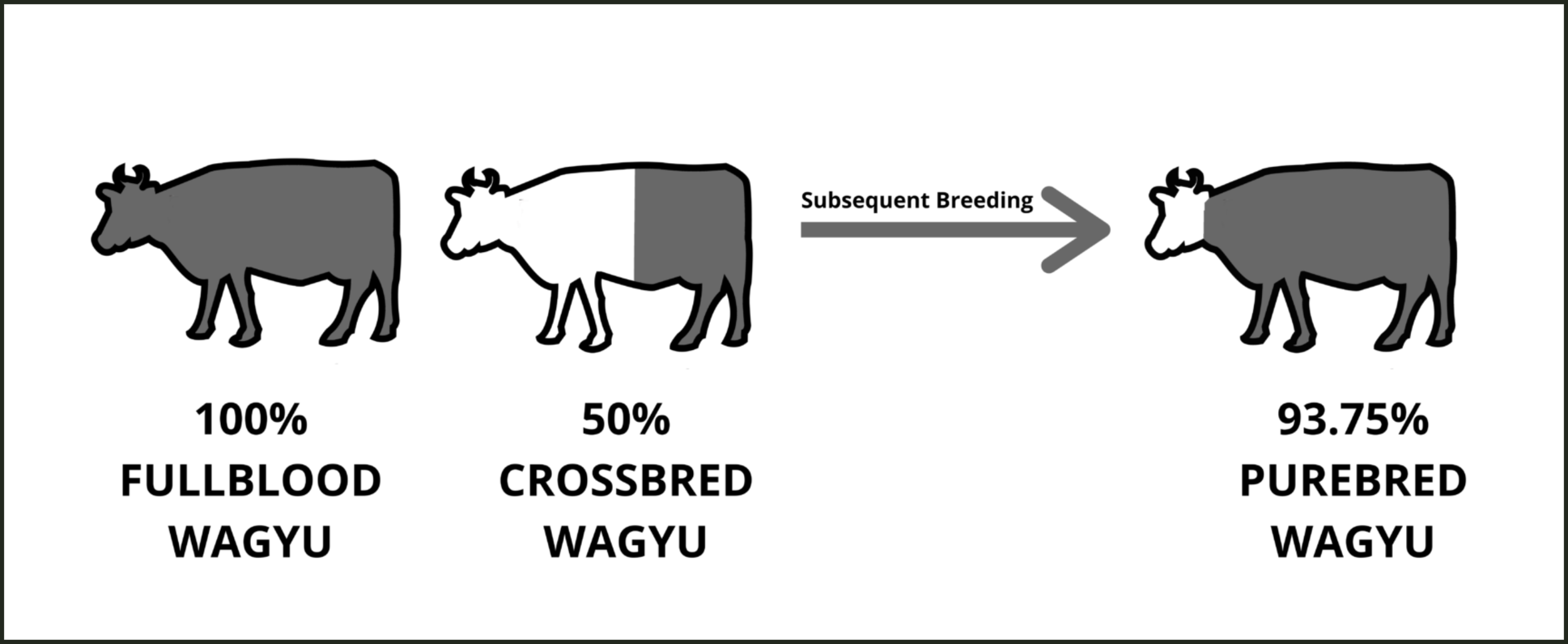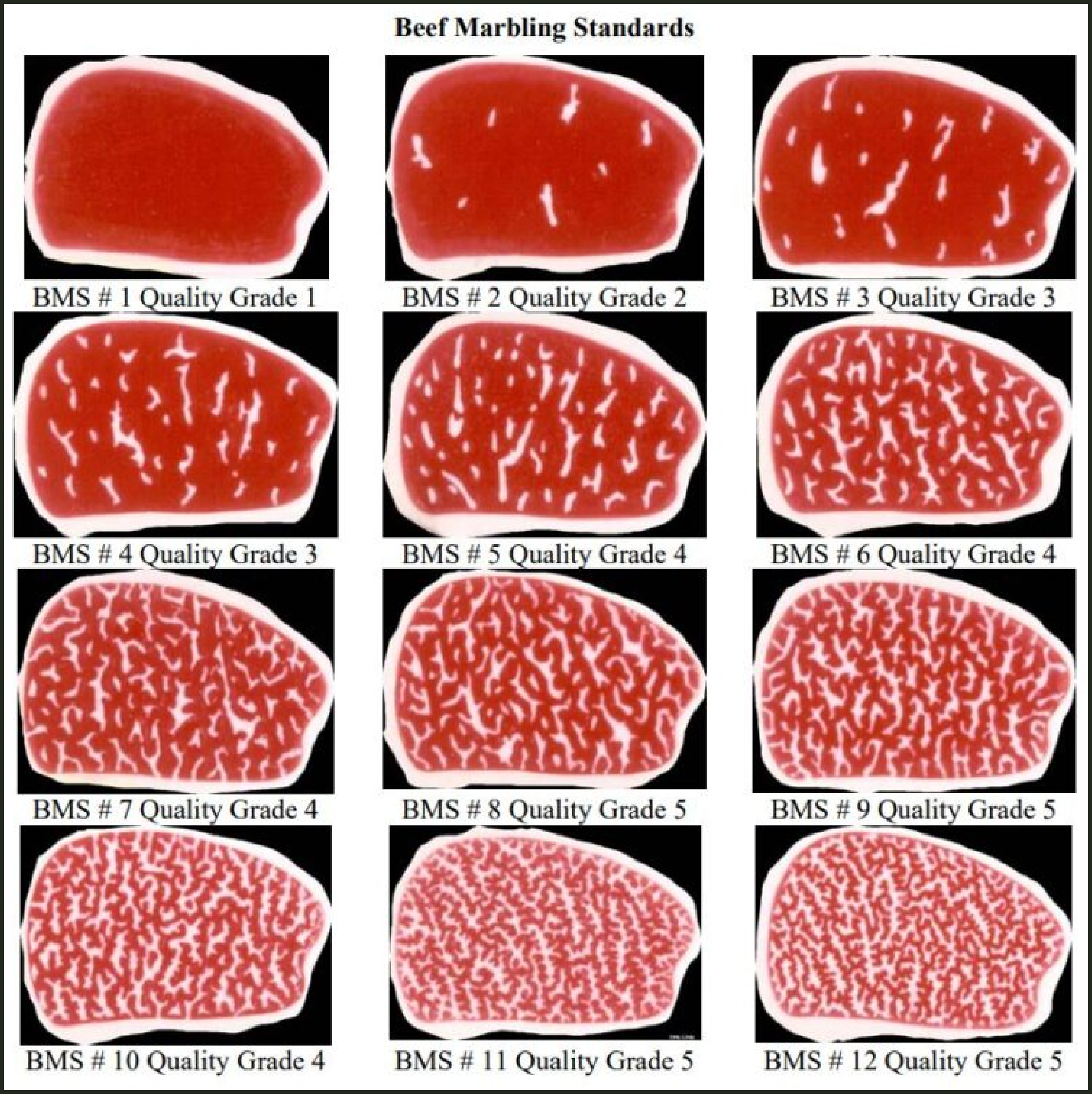Wagyu
Wagyu are a medium- to large-sized breed, with mature cows from 1,000 to 1,400 pounds and mature bulls from 1,700 to 2,200 pounds. Unlike many commercialized breeds, Wagyu are docile and easy to handle. There are four types of Wagyu: Japanese Shorthorn, Japanese Black, Japanese Brown, and Japanese Polled. They have a broad forehead, compact body structure, and their coats can be black or red in color.
Breed History
Having migrated from Northern China in the second century A.D., the Japanese originally enlisted Wagyu cattle for rice cultivation, mining, forestry, and transportation. For religious reasons, eating beef was not popular in Japan. During the Meiji Restoration in 1868, however, the new government introduced Western culture and eating habits, allowing for the consumption of farm animals. This resulted in an increased demand for beef production and a corresponding increase in the number of cattle breeders. To help meet this demand, the Japanese government imported several foreign breeds to increase production and genetically improve local cattle breeds. These imported breeds included Devon, Ayrshire, Brown Swiss, Aberdeen Angus, Shorthorn, Simmental, and Holstein.
Wagyu depicted in Ukiyo-e. From “The Sixty-nine Stations of the Kiso Kaidō” by Hiroshige Utagawa.
Wagyu were first introduced to the United States in 1976 when four bulls, two black and two brown, were shipped from Japan by Morris Whitney. These bulls were used for research and then bought by Wagyu Breeders Inc. It was not until 1993 that female Wagyu were brought to the U.S. by the Mannett Group. This meant that prior to 1993 all Wagyu offspring were crosses with other breeds.
A Fullblood Wagyu is 100% Wagyu. When a Fullblood Wagyu is bred to another cattle breed the offspring is called an F1and is 50% Wagyu and 50% another breed. With subsequent breeding of the crossbred Wagyu animals with Fullblood Wagyu, the offspring increase in the percentage of Wagyu breed. Once the cattle are 93.75% Wagyu or more, the animal is considered a Purebred Wagyu animal. This breeding scheme allows for other breeds to influence characteristics that may not be very desirable in Wagyu such as milking abilities, carcass weights, or calving size.
Meat Characteristics
Wagyu is best known for its unique marbling that exceeds the USDA standards of Prime quality. The Japanese standards of grading integrate a Meat Quality Grade and a Yield Grade to grade an individual head of cattle. The Meat Quality Grade ranges from 1–5 and includes an analysis of the following qualities: beef marbling, meat color and texture, and fat color and quality. The Beef Marbling Score examines the percentage of intramuscular fat present in the meat. This number ranges from 1–12, with scores of 8–12 corresponding to a 5-quality grade. The Yield Score is an estimate of the percentage of edible cuts in an animal and ranges from A–C. Being the highest score, A represents a yield estimated percentage of 72% or higher, B represents 69%–71%, and C represents a yield estimated percentage under 69%. Although we do not produce A5 beef according to the Japanese scale, our Wagyu beef exceeds prime quality in terms of the US scale.
References
American Wagyu Association. “Breed Info.”, 2021, https://wagyu.org/breed-info/. American Wagyu Association. “What is Wagyu?”, 2021, https://wagyu.org/breed-info/what-is-wagyu/. Busboom, J. R., and J. J. Reeves. “Japanese Meat Grading.” Washington State University 3rd Symposium, 1997. Global Ag Media. “Cattle Breeds – Wagyu.”, https://www.thecattlesite.com/breeds/beef/49/wagyu/. Lone Mountain Wagyu. “A History of Wagyu Beef – Infographic.”, January 11, 2018, https://blogs.lonemountainwagyu.com/a-history-of-wagyu-beef-infographic. Lone Mountain Wagyu. “The History of Wagyu in America.”, January 11, 2018, https://blogs.lonemountainwagyu.com/the-history-of-wagyu-in-america. Namikawa, Kiyoshi. “Breeding History of Japanese Beef Cattle and Preservation of Genetic Resources as Economic Farm Animals.” Washington State University 3rd Symposium, 1997. Rocking 711 Ranch. “Wagyu History Outside Japan.”, http://www.rocking711.com/wagyu-history-outside-japan/. Twinwood Cattle Company. “Wagyu History in Japan.”, https://twinwoodcattle.com/breed-history/wagyu-history-japan. Wagyu International. “Wagyu Around the World – Japan.” http://www.wagyuinternational.com/global_Japan.php. Wagyu International. “Wagyu Around the World – USA.” http://www.wagyuinternational.com/global_USA.php. Busboom, J. R., and J. J. Reeves. “Japanese Meat Grading.” Washington State University 3rd Symposium, 1997.






